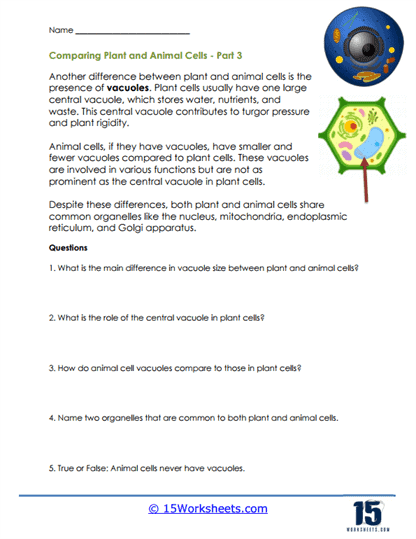Comparing Vacuole Size

Worksheet Description
This worksheet emphasizes the differences and similarities between plant and animal cells in terms of their vacuoles. It elucidates that plant cells characteristically possess one large central vacuole that plays a pivotal role in storing water, nutrients, and waste while contributing to turgor pressure and overall cell rigidity. In contrast, animal cells, when they have vacuoles, contain smaller and fewer vacuoles that serve different functions and are less pronounced than the central vacuole in plant cells. Additionally, the worksheet mentions shared organelles in both cell types, like the nucleus, mitochondria, endoplasmic reticulum, and Golgi apparatus, with questions geared towards reinforcing these points.
To effectively engage with this worksheet, a student should initiate the process by meticulously reading through the provided content, absorbing the distinctive features of vacuoles in plant and animal cells. By visualizing or drawing a comparative diagram of plant and animal cells, highlighting their vacuoles, the student can grasp a clearer picture of the differences. Upon understanding the primary functions and implications of these vacuoles, they should then address the given questions, referring back to the text for precision and comprehension. By integrating the acquired knowledge with the questions, the student can thoroughly assess and validate their understanding of the subject.
The primary aim of this worksheet is to impart knowledge about the fundamental distinctions and shared attributes of plant and animal cells, particularly focusing on vacuoles. By delineating the unique structure and functions of vacuoles in each cell type, the worksheet helps students to discern the specialized roles these organelles play in maintaining cell health and functionality. The included questions serve to reinforce this understanding, prompting students to delve deeper into the subject matter. In essence, this educational resource endeavors to nurture a nuanced understanding of cellular biology, fostering an appreciation for the intricacies and marvels of life at a microscopic level.
